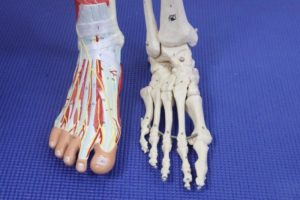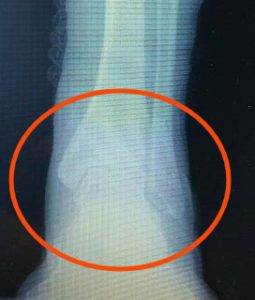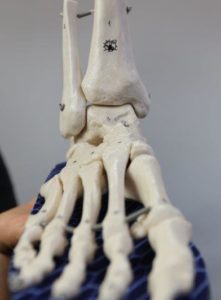Foot & Ankle Injury Treatment
Signs of Broken Ankle Vs. Sprained Ankle: Diagnosis & Best Treatment!
Signs of Broken Ankle Vs. Sprained Ankle: Make 100% sure you aren’t missing the proper diagnosis. Get the best FASTER and Confidently!
Table of Contents
Signs Of A Broken Ankle:

A Broken Ankle Usually Includes Trauma:
- A suddenly twisted or bent ankle.
- Tripping or falling over something.
- The severe impact such as a fall.
- Trauma experienced in a car accident.
- Even an awkward step down the stairs can cause it.
Symptoms of a broken ankle:
- Severe pain.
- Ankle swelling to the injured area.
- Bruising & purple skin.
- Very tender region.
- Inability to put weight on the ankle.
- Possible deformity to the area.
A Broken Ankle Vs. Sprained Ankle:
1)Sprained Ankle:
Ankle Sprain symptoms:
- Pain, mostly on the outside.
- Swelling & redness.
- Increase in the fluid within the area.
- Decrease in joint mobility.
- You still can have significant bruising and swelling.

How long does an ankle sprain last?
- Most ankle injuries heal in about 1-2 weeks at most.
- There are types of ankle sprains that cause rupture of the ligaments.
- These injuries may need surgery & may take 2-3 months to heal.
- But in 90%+ of cases, you should start feeling better after a few days.
- This is especially true if you use anti-inflammation treatment protocols.
Ankle Sprain:
If it does seem like you have a sprained ankle rather than a broken ankle: Follow this guide to find out exactly how long your ankle treatment will take.
Keys to ankle sprain treatment include:
- Rest, Ice, Compression, Inflammation.
- Protection.
- Physiotherapy.
- X-ray, CT, MRI, or nuclear imaging of the joint.
There are three grades of sprained ankles:
- Make sure to see your podiatrist most of all to make sure that you are not missing anything, don’t take advice on something so serious from someone online!
- Grade 1 sprained ankle requires probably 1 to 2 days of rest, ice, compression, and elevation. At this point, you still want to be protected with a good supportive shoe and lace-up ankle brace for about 1-2 weeks.
- A grade 2 sprained ankle requires around 3 to 5 days of rest, ice, compression, and elevation. And you still want to get a good supportive shoe and lace ankle brace for probably around the next 2 to 6 weeks.
- A grade 3 sprained ankle will require 5 to 7 or more days of rest, ice, compression, and elevation. You probably do have to take a break from sports at this time. And you want to get a good supportive shoe and lace-up ankle brace for probably even over six weeks up to three months. The next paragraph for grade 3 ankle sprain probably wanted to see your podiatrist and get this, evaluate, you probably do need x-rays and probably even an MRI to make sure that you do not have any further damage.

2) Broken Ankle:
It is very difficult to tell the difference between a sprained ankle & a broken ankle. But these signs might make diagnosis more likely:
- Gross deformity.
- Dislocation of the ankle.
- Difficulty moving the ankle.
- Cracking or snapping noise during the injury.
- More severe trauma: large fall or motor vehicle injury.
Broken Ankle Vs. Sprained Ankle Prediction:
The Ottawa Ankle Rules are a system designed to predict if someone is more likely to have an ankle injury or a sprained ankle:
A broken ankle is more likely if:
1)Pain in the tibia 6 cm within the ankle.
- Two bones make up your leg.
- The tibia is the inside & the fibula is the outside of the leg.
- The tibia is a major weight-bearing bone.
2)Pain in the fibula 6 cm within the ankle.
- The fibula is the outside of your leg.
- It makes the outside boney part of your ankle.
- If pushing against it hurts, it may be an ankle fracture.
- **The soft area below the edge of the bone will hurt in an ankle sprain, but not the bone itself!**
3) You cannot stand on the ankle.
- If you cannot bear weight, this is more likely a fracture.
- Especially a couple of days later if you have been icing & elevating the leg.
4)Tenderness on the outside bone of your foot.
- If the middle outside bone of your foot (5th metatarsal) is hurting, you may have a Jones fracture.
- This is not a broken ankle but can be just as serious.
- The 5th metatarsal is a weight-bearing bone & if broken, can take a very long time to heal.
5)Tenderness when you press on top of the foot (less likely):
- The bones in the middle of your foot may be broken.
- But this is much more unlikely.
6) Unable to bear weight on your foot after a couple of days.
- Especially if you have been icing, elevating & taking anti-inflammatories.
- Just like not being able to put ankle, this also happens with your foot!
Traumatic Injury Treatment:
- If you have a traumatic injury such as a severe bruise or broken bone, or even a ruptured tendon: consider protecting your foot!
- The best way to do this is to see your podiatrist and get evaluated with an x-ray and a potential MRI or CT scan.
- If you are unable to do so, it may benefit you to be in a cast, fractured boot, or even keep the weight off of it with a rolling knee scooter or other protective devices.
- We as podiatrists frequently take patients off work for very long periods of time when they suffer a traumatic injury. Unfortunately, there is no other way around us in labor jobs.
- If you have a sit-down job, there are ways to get people back to work quicker, but this can be very difficult otherwise.
Ankle Fracture Best Boot Options:
- A cast may be indicated initially, but gradually there are some benefits to a removal air cast.
- This has recently been shown to be more and more beneficial for ankle fractures.
- Our favorite fracture boots and their supplies:








Ankle Fracture Best Scooter Options:
- Crutches can be very difficult on the inside of the armpits. This can cause significant pain, especially considering how long it takes to heal the broken ankle.
- These are favorite knee scooters and walking devices:








Broken Ankle Rehab & Treatment:
There are 5 essential things that you may need to help you with your broken ankle recovery time!
The five essential things include the number one most important:
- You do have to see your podiatrist and foot specialist diagnose your broken ankle! We cannot do this for you as an online service. If you have dark bruising and swelling, there is a good chance that you may be having a problem.
- So important tip number one is to go see your podiatrist for your broken ankle or your broken foot to make sure.
- Stuff that we can help you with is providing you some more cost-effective alternatives for some products.
- Things that you will need are most likely a rolling the scooter to stay off your foot for a long period of time. He probably will need either a cast or a fracture boot.
- You will probably need a cast protectorate to avoid getting it wet, so you don’t smell and that your significant other doesn’t leave you.
- And most likely you will also need a cast elevator to keep your foot elevated so that it does not swell extensively.
Phase 1 of your broken ankle recovery:






Phase 2 of your broken ankle recovery:




Pain treatment options for a broken or sprained ankle:








